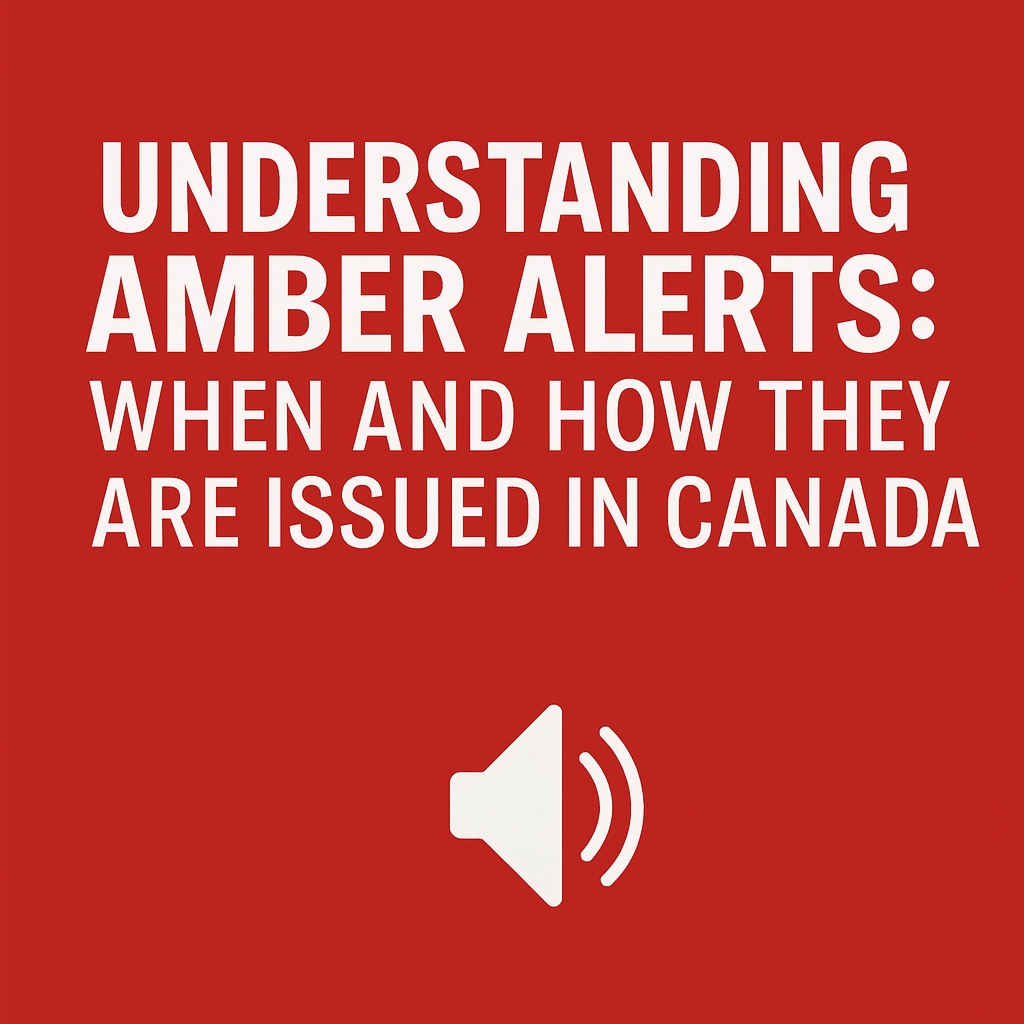🚨 Understanding Amber Alerts: When and How They Are Issued in Canada
Amber Alerts are one of the most critical tools used to locate abducted children in Canada. They quickly notify the public through mass communication channels when a child is believed to be abducted and in imminent danger. While highly effective, Amber Alerts are only issued under specific circumstances, and not every missing child case qualifies.
📜 History of Amber Alerts in Canada
The Amber Alert system originated in the United States in 1996 following the abduction and murder of 9-year-old Amber Hagerman in Arlington, Texas. Her case sparked the creation of a rapid broadcast emergency response system to help find abducted children.
Canada’s first provincial Amber Alert system was launched in Alberta in December 2002, led by Solicitor General Heather Forsyth. The system was adopted shortly after by Ontario (2003) and then by other provinces and territories over the next several years.
Today, every province and territory in Canada participates in the national Amber Alert protocol, using consistent criteria while operating their own regional response systems.
📌 What Is an Amber Alert?
An Amber Alert is an emergency broadcast issued by police to alert the public about a child under 18 who is believed to have been abducted and is in imminent danger. The alert includes vital information such as the child’s description, potential suspect or vehicle, and instructions for how the public can help.
📋 Criteria for Issuing an Amber Alert in Canada
- The child must be under 18 years old.
- There is reason to believe the child has been abducted.
- The child is believed to be in imminent danger.
- There is enough descriptive information about the child, abductor, or vehicle to assist in locating them.
- The alert must be issued within a reasonable timeframe from the abduction (usually within a few hours).
🌐 How Amber Alerts Are Broadcast
Amber Alerts are disseminated using Canada’s Alert Ready system, reaching millions of people across multiple platforms:
- Wireless alerts to smartphones (even on silent mode)
- Interruptions on TV and radio programming
- Electronic highway signs and billboards
- Social media posts from police and media outlets
The alerts are issued by provincial or territorial police agencies, such as the RCMP, Ontario Provincial Police (OPP), or Sûreté du Québec (SQ).
⚠️ Why Some Missing Child Cases Don’t Qualify
Amber Alerts are only used for the most urgent abduction cases. A child who is missing but not believed to be abducted, such as a runaway, does not meet the criteria. Additionally, if police lack enough information (e.g., suspect or vehicle details), an alert may not be issued.
In these cases, law enforcement may still release public statements, share information through social media, or issue a general missing person bulletin.
📊 Do Amber Alerts Work?
Yes. Amber Alerts have played a key role in the safe recovery of many children. Rapid public awareness increases the chances of identifying the child, vehicle, or abductor before they leave the area.
However, the system relies on the public’s attention. That’s why it is reserved for specific, verified scenarios to avoid alert fatigue and ensure credibility.
🗺️ Amber Alerts by Province
- Alberta: First to implement Amber Alerts in 2002.
- Ontario: Adopted the system in 2003, managed by OPP.
- Quebec: Known as “Alerte AMBER,” managed by Sûreté du Québec.
- British Columbia: Administered by the RCMP’s E Division.
👉 What You Can Do
- Keep emergency alerts enabled on your phone.
- Take Amber Alerts seriously and be vigilant when one is issued.
- Report any relevant sightings or tips to police immediately.
- Share Amber Alerts on social media to expand their reach.
💛 Help Us Continue This Work: Support us on Ko-fi.
🚨 Comprendre les Alertes AMBER : Quand et comment elles sont émises au Canada
Les alertes AMBER sont des outils essentiels pour localiser rapidement les enfants enlevés. Lorsqu’un enfant est en danger immédiat, une alerte est envoyée à la population par divers canaux pour aider à sa localisation. Toutefois, toutes les disparitions ne déclenchent pas une alerte AMBER.
📜 Historique des alertes AMBER au Canada
Le système AMBER a été créé après l’enlèvement et le meurtre d’Amber Hagerman, une fillette de 9 ans au Texas, en 1996. Son histoire a mené à la création d’un système d’alerte publique pour retrouver les enfants disparus.
Au Canada, la première province à adopter ce système fut l’Alberta en décembre 2002. L’Ontario a suivi en 2003, et toutes les provinces et territoires ont ensuite mis en place leurs propres systèmes basés sur des critères nationaux.
📌 Qu’est-ce qu’une alerte AMBER ?
Une alerte AMBER est une notification d’urgence diffusée lorsqu’un enfant de moins de 18 ans est présumé enlevé et en danger imminent. Elle contient des détails essentiels pour aider le public à reconnaître l’enfant, le suspect ou un véhicule associé.
📋 Critères d’émission au Canada
- L’enfant doit être âgé de moins de 18 ans.
- Il doit y avoir des raisons de croire qu’il s’agit d’un enlèvement.
- Un danger imminent pour l’enfant doit être identifié.
- Des informations descriptives doivent être disponibles.
- L’alerte doit être déclenchée dans un délai raisonnable suivant l’enlèvement.
🌐 Comment les alertes sont diffusées
Grâce au système Alert Ready, les alertes AMBER sont diffusées via :
- Alertes sans fil sur les téléphones (même en mode silencieux)
- Interruption des émissions radio et télé
- Panneaux routiers électroniques
- Médias sociaux et communiqués policiers
⚠️ Pourquoi certaines disparitions ne déclenchent pas une alerte
Si l’enfant est porté disparu mais qu’il n’y a aucun signe d’enlèvement ou trop peu d’informations, une alerte AMBER ne sera pas émise. Cela peut être frustrant, mais les critères sont conçus pour maintenir l’efficacité et la crédibilité du système.
📊 Les alertes AMBER sont-elles efficaces ?
Oui. De nombreux enfants ont été retrouvés grâce à la vigilance du public. Toutefois, le système dépend de l’attention collective — d’où l’importance de limiter les alertes aux cas vraiment urgents.
🗺️ Alertes AMBER par province
- Alberta : Première province à adopter le système en 2002.
- Ontario : A suivi en 2003 (géré par la PPO).
- Québec : “Alerte AMBER,” géré par la Sûreté du Québec.
- Colombie-Britannique : Géré par la GRC.
👉 Ce que vous pouvez faire
- Laissez les alertes d’urgence activées sur votre téléphone.
- Restez attentif aux alertes AMBER et partagez-les rapidement.
- Signalez toute information pertinente au 911.
- Sensibilisez votre entourage à l’importance des alertes.
💛 Aidez-nous à poursuivre ce travail : Soutenez-nous sur Ko-fi.







